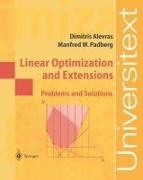Read more
Books on a technical topic - like linear programming - without exercises ignore the principal beneficiary of the endeavor of writing a book, namely the student - who learns best by doing course. Books with exercises - if they are challenging or at least to some extent so exercises, of - need a solutions manual so that students can have recourse to it when they need it. Here we give solutions to all exercises and case studies of M. Padberg's Linear Optimization and Exten sions (second edition, Springer-Verlag, Berlin, 1999). In addition we have included several new exercises and taken the opportunity to correct and change some of the exercises of the book. Here and in the main text of the present volume the terms "book", "text" etc. designate the second edition of Padberg's LPbook and the page and formula references refer to that edition as well. All new and changed exercises are marked by a star * in this volume. The changes that we have made in the original exercises are inconsequential for the main part of the original text where several ofthe exercises (especiallyin Chapter 9) are used on several occasions in the proof arguments. None of the exercises that are used in the estimations, etc. have been changed.
List of contents
1 Introduction.- 1.1 Minicases and Exercises.- 2 The Linear Programming Problem.- 2.1 Exercises.- 3 Basic Concepts.- 3.1 Exercises.- 4 Five Preliminaries.- 4.1 Exercises.- 5 Simplex Algorithms.- 5.1 Exercises.- 6 Primal-Dual Pairs.- 6.1 Exercises.- 7 Analytical Geometry.- 7.1 Points, Lines, Subspaces.- 7.2 Polyhedra, Ideal Descriptions, Cones.- 7.3 Point Sets, Affine Transformations, Minimal Generators.- 7.4 Double Description Algorithms.- 7.5 Digital Sizes of Rational Polyhedra and Linear Optimization.- 7.6 Geometry and Complexity of Simplex Algorithms.- 7.7 Circles, Spheres, Ellipsoids.- 7.8 Exercises.- 8 Projective Algorithms.- 8.1 A Basic Algorithm.- 8.2 Analysis, Algebra, Geometry.- 8.3 The Cross Ratio.- 8.4 Reflection on a Circle and Sandwiching.- 8.5 A Projective Algorithm.- 8.6 Centers, Barriers, Newton Steps.- 8.7 Exercises.- 9 Ellipsoid Algorithms.- 9.1 Matrix Norms, Approximate Inverses, Matrix Inequalities.- 9.2 Ellipsoid "Halving" in Approximate Arithmetic.- 9.3 Polynomial-Time Algorithms for Linear Programming.- 9.4 Deep Cuts, Sliding Objective, Large Steps, Line Search.- 9.5 Optimal Separators, Most Violated Separators, Separation.- 9.6 ?-Solidification of Flats, Polytopal Norms, Rounding.- 9.7 Optimization and Separation.- 9.8 Exercises.- 10 Combinatorial Optimization: An Introduction.- 10.1 The Berlin Airlift Model Revisited.- 10.2Complete Formulations and Their Implications.- 10.3 Extremal Characterizations of Ideal Formulations.- 10.4 Polyhedra with the Integrality Property.- 10.5 Exercises.- Appendices.- A Short-Term Financial Management.- A. 1 Solution to the Cash Management Case.- B Operations Management in a Refinery.- B.l Steam Production in a Refinery.- B.2 The Optimization Problem.- B.3 Technological Constraints, Profits and Costs.- B.4Formulation of the Problem.- B.5 Solution to the Refinery Case.- C Automatized Production: PCBs and Ulysses' Problem.- C.l Solutions to Ulysses' Problem.
Additional text
From the reviews of the first edition:
"... This book is a useful supplement to the textbook [W.Padberg, Linear Optimization and Extensions, 2nd ed., Springer, Berlin 1999]. It serves the purpose well to train MATHEMATICAL optimizers, but has little impact on the education of mathematical OPTIMIZERS, i.e. it concentrates on mathematics, but not on problem solving in reality. It is a valuable contribution for students in mathematics, but may be less suitable for students of economics or business administration."
OR-Spektrum, Issue 14, p.37, 2002
"Die in diesem Werk präsentierten Übungsaufgaben wurden überarbeitet, ergänzt, und werden im vorliegenden Text samt Lösungen und geraffter Zusammenfassung der notwendigen theoretischen Resultate präsentiert. ... Bemerkenswert ist weiters, daß auch Programmieraufgaben gestellt und gelöst werden. ... Insgesamt ist das Buch sowohl als Quelle für Übungsaufgaben zu Vorlesungen über Lineare Optimierung als auch zum Selbststudieum sehr gut geeignet."
F.Rendl (Klagenfurt), IMN - Internationale Mathematische Nachrichten 190, 2002, S. 76-77
"Do you know M. Padberg’s Linear Optimization and Extensions (second edition, Springer-Verlag, Berlin, 1999)? If you teach a course on linear programming then you should know it. ... Now here is the continuation of it, discussing the solutions of all its exercises and with detailed analysis of the applications mentioned. … For those who cherish the original textbook (students and lecturers) this is an extremely valuable sequel. For those who strive for good exercises and case studies for LP this is an excellent volume." (Péter Hajnal, Acta Scientiarum Mathematicarum, Vol.69, 2003)
Report
From the reviews of the first edition:
"... This book is a useful supplement to the textbook [W.Padberg, Linear Optimization and Extensions, 2nd ed., Springer, Berlin 1999]. It serves the purpose well to train MATHEMATICAL optimizers, but has little impact on the education of mathematical OPTIMIZERS, i.e. it concentrates on mathematics, but not on problem solving in reality. It is a valuable contribution for students in mathematics, but may be less suitable for students of economics or business administration."
OR-Spektrum, Issue 14, p.37, 2002
"Die in diesem Werk präsentierten Übungsaufgaben wurden überarbeitet, ergänzt, und werden im vorliegenden Text samt Lösungen und geraffter Zusammenfassung der notwendigen theoretischen Resultate präsentiert. ... Bemerkenswert ist weiters, daß auch Programmieraufgaben gestellt und gelöst werden. ... Insgesamt ist das Buch sowohl als Quelle für Übungsaufgaben zu Vorlesungen über Lineare Optimierung als auch zum Selbststudieum sehr gut geeignet."
F.Rendl (Klagenfurt), IMN - Internationale Mathematische Nachrichten 190, 2002, S. 76-77
"Do you know M. Padberg's Linear Optimization and Extensions (second edition, Springer-Verlag, Berlin, 1999)? If you teach a course on linear programming then you should know it. ... Now here is the continuation of it, discussing the solutions of all its exercises and with detailed analysis of the applications mentioned. ... For those who cherish the original textbook (students and lecturers) this is an extremely valuable sequel. For those who strive for good exercises and case studies for LP this is an excellent volume." (Péter Hajnal, Acta Scientiarum Mathematicarum, Vol.69, 2003)

